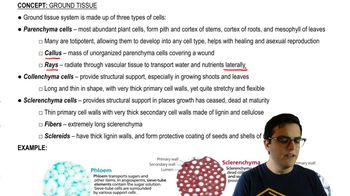33. Plant Anatomy
Tissues
Learn with other creators
Practice this topic
- Multiple ChoiceArtichoke hearts are tender and have a strong taste. The leaves have a strong taste, too, but most of an artichoke leaf is fibrous and too difficult to chew. The leaves must contain lots of __________.757views
- Multiple ChoiceThe plant tissue system most analogous to our circulatory system is the __________.977views
- Multiple ChoiceGround tissue is composed of undifferentiated cells with thin walls that are usually involved with storage. The inner portion of the ground tissue of a nonwoody stem is called __________, and the outer portion is called __________.800views
- Multiple ChoiceWhich of the following cells are dead at functional maturity?1565views
- Textbook Question
What is a sieve-tube element?
a. The sugar-conducting cell found in phloem
b. The widened, perforation-containing, water-conducting cell found only in angiosperms
c. The nutrient- and water-absorbing cells found in root hairs
d. The nucleated and organelle-rich support cell found in phloem
629views - Textbook Question
The innermost layer of the root cortex is the
a. Core
b. Pericycle
c. Endodermis
d. Pith
932views - Textbook Question
Evaluate the following statements regarding tracheids and vessel elements.
Select True or False for each statement.
T/F Both tracheids and vessel elements are specialized for water conduction.
T/F Both tracheids and vessel elements have pits.
T/F Vessel elements have perforation plates but tracheids do not.
T/F Tracheids and vessel elements have to be alive in order to transport water.
674views - Textbook Question
Splicing begins:
a. As transcription occurs.
b. After transcription is complete.
c. As translation occurs.
d. After translation is complete.
903views
















